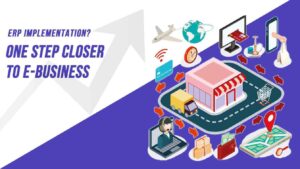How To Improve Your Business With ERP Implementation?
What is an ERP? ERP is enterprise software that manages all the core business functions required to run a company, such as accounting, procurement, inventory management, human resources, customer relationship management, and much more. ERP helps businesses integrate their multi-departmental activities and improve overall efficiency. For example, an ERP system can help you track your inventory levels across all your warehouses, manage your employees’ vacation requests, and automate the billing process for your customers. This allows you to streamline your operations, reduce errors, and save time. Enterprise Resource Planning (ERP) implementation can be a game-changer for your business. With 95% of businesses reporting business process improvement after implementing ERP, it’s time to take the next step for your organization. How to Improve Your Business with ERP Implementation? Enterprise Resource Planning (ERP) is an essential tool for businesses to streamline all their operations and improve their overall productivity. ERP implementation can help improve the way businesses handle their data, automate key processes, and enhance operational efficiency. In this blog, we will discuss the benefits of ERP implementation and how to get it right. Benefits of ERP implementation for businesses ERP implementation provides a range of benefits for businesses of all sizes, from SMEs to large enterprises. Let’s take a closer look at some of the key benefits of ERP implementation. 1) Centralized data management: ERP implementation provides a single source of data for all departments, such as finance, sales, marketing, and HR. This means all teams have access to the same information, which helps minimize errors and avoids contradictions. 2) Standardization of processes: Another benefit of ERP implementation is that it standardizes business processes. This means all your employees are operating under the same rules and procedures, making processes consistent across the organization. 3) Automation of routine activities: With ERP implementation, you can automate routine tasks such as invoicing and accounting. Automation frees up personnel to focus on other important tasks such as analyzing the data and making vital business decisions. 4) Improved productivity: ERP implementation provides employees with access to the information they need in real-time, so they can make decisions faster and with greater accuracy. With an ERP system, you can also eliminate manual data entry and reduce errors, promoting productivity throughout the organization. 5) Better visibility and transparency: ERP implementation provides business owners with real-time visibility and transparency of their company’s operations. This means you can access information on-demand and make better business decisions based on accurate data. 6) Scalability: ERP systems can grow with your business. Adding modules or users to the system can be done with ease, ensuring the system can scale to meet the demands of the business. How to implement ERP successfully ERP implementation is a complex process that requires careful planning and organization. Below are some tips on how to implement ERP successfully: 1) Define your business needs: The first step in implementing an ERP system is to identify the business processes that require improvement. This will help you decide which functions you need to automate. You can conduct a needs assessment or seek advice from an ERP consultant to help you identify your business’s core needs. 2) Choose the right vendor: Choose an ERP vendor with a track record of successful implementations. Look for a vendor that provides comprehensive support, including training, integration services, and technical support. 3) Plan your implementation: Every step of the ERP implementation process needs to be carefully planned out to avoid costly mistakes. You should create a detailed implementation plan outlining the scope of the project, timelines, budget, and any potential risks or challenges. 4) Train your employees: Invest in employee training to help them adapt to the new ERP system. Employees who are well-trained are more likely to understand the system’s capabilities, leading to an increase in efficiency and productivity. 5) Monitor and measure success: Once the ERP system is up and running, it’s important to monitor its performance metrics. This can include tracking user adoption rates, system utilization rates, and more. Tracking these metrics will help you determine whether the system is achieving the desired goals or not. Steps to improve ERP implementation: 1- Assess Current Systems: Take a look at your current systems and identify areas where improvements are possible. This assessment will help you understand the current state of your business operations and where there are inefficiencies or bottlenecks that can be improved using ERP implementation. 2- Define Project Scope and Goals: Understanding current business processes will help in setting goals and objectives for ERP implementation. Decide on key performance indicators and quantify your desired results. 3- Select Software: Choose an ERP software that meets your specific requirements and fits within your budget. 4- Configure Systems: Configure the ERP system to meet your specific needs. 5- Migrate and Prepare Data: Migrate data from your existing systems to the new ERP system and prepare it for use. 6- Testing: Test the ERP system to ensure that it is functioning correctly and meeting your needs. 7- Training Employees: Arrange a customized training facility with employee-specific needs. Training programs and workshops remarkably strengthen workplace efficiency. 8- Implement: Implement the ERP system within your organization. 9- Provide Ongoing Maintenance and Support: Provide ongoing maintenance and support to ensure that the ERP system continues to meet your needs. By following these steps, you can improve the efficiency and effectiveness of your organization’s business processes, provide real-time data and reporting capabilities, increase productivity, reduce costs, and improve data accuracy. Final thoughts. ERP implementation can help businesses streamline their operations, improve efficiency, and ultimately achieve business success. Implementing an ERP system is a complex process, but with proper planning and execution, the benefits for your business can be transformative. With the benefits and tips outlined above, you can make an informed decision about implementing ERP in your business.


